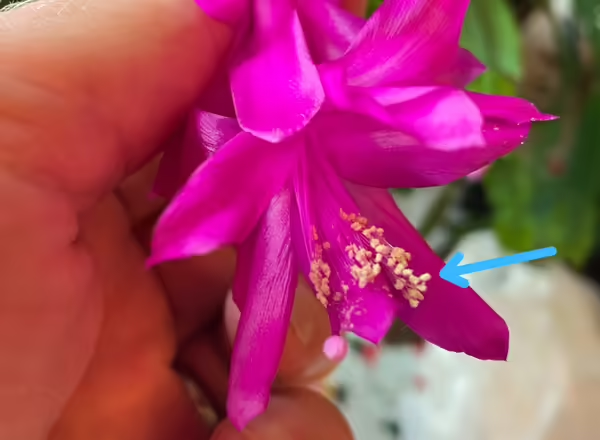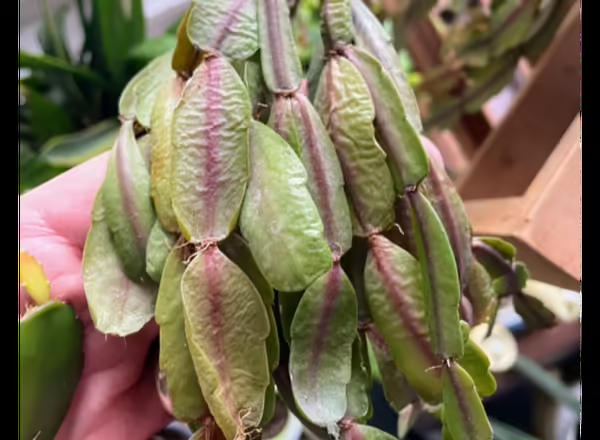
Poinsettias, Amaryllis, holly, and evergreens are common sights during the holidays. Another group of plants, holiday cacti, also make an appearance this time of year. With their brightly colored flowers ranging from white, pink, yellow, orange, red, or purple, they can be a great addition to your holiday décor.
Unlike many of our holiday plants, they are often kept and grown as houseplants after the holidays. They can also be very long-lived. It’s not unheard of for plants to be 100 years old and passed down from generation to generation.
While they are commonly referred to as Christmas cactus, there are several different types of holiday cacti sold: the Thanksgiving cactus, Schlumbergera truncata; the Christmas cactus, Schlumbergera x buckleyi and Schlumbergera bridgesii; and the Easter/Spring cactus, Rhipsalidopsis gaertneri. They get their common names from the holiday closest to their traditional bloom dates. However, they may be forced to bloom at other times of the year.

What holiday cacti do I have?
Most of the ‘Christmas cactuses’ sold are actually Thanksgiving cacti. To differentiate between the three types of holiday cacti, look at their ‘leaves’ (the ‘leaves’ are actually flattened stem segments called phylloclades, not true leaves). Thanksgiving cacti, also known as crab cacti, have pointed teeth along the outside margins of the leaves that look like hooks or claws. Christmas cacti have smooth, more rounded/scalloped margins. Easter cacti have rounded margins.
The flowers can also be used to differentiate the different types. Both Thanksgiving and Christmas cacti have tubular flowers. However, the anthers of Thanksgiving cacti are yellow, and Christmas cacti are purplish-brown. Easter cacti, on the other hand, have star-shaped flowers.
Timing of the blooms can sometimes be helpful, but plants can be forced to bloom outside of their ‘normal’ blooming period. Thanksgiving cacti will typically bloom from late November to late December, which is why we often see them in the lead-up to Christmas. Christmas cacti typically bloom from late December to March, and Easter/Spring cacti typically bloom from March to May.



Caring for holiday cacti
While holiday cacti are true cacti, they are quite different from the cacti growing in deserts. Holiday cacti are native to tropical mountainous regions of southeast Brazil. They do not grow in the ground but are epiphytic, growing in the crotches of trees where debris and organic matter build-up. Keeping this in mind, their cultural requirements are quite different from desert-growing cacti.
While plants are blooming, they should be placed in bright, indirect light with temperatures ranging from 70°F during the day to 55-65°F at night. Soil should be kept moist, but make sure they aren’t sitting in water. If plants get too dry while blooming, plants may drop their flowers.
Once done flowering, they can be grown as houseplants. Cut back on watering slightly until new growth begins to appear (keep plants on the dry side). Then, resume watering like normal (allowing the soil to dry out slightly between waterings). Fertilize plants with a complete house plant fertilizer once growth resumes in the spring through late summer. During the summer, they can be placed outside in an area that receives light shade. If they are exposed to too much light, plants may turn pale green or become sunburnt (remember, they often grow as epiphytes on trees in their native range).
Once temperatures start getting into the low 50s°F at night in the fall, they should be brought indoors. However, before bringing them indoors, make sure to scout for and manage any pests that may be present.
Holiday cacti flower best when they are somewhat pot-bound, so they only need to be repotted every three years or so. Repotting is best done in the spring. Since they are epiphytes, they don’t grow in heavy (wet) potting mixes. Rather they grow best in mixes that are well-drained and have good aeration. They are often grown in potting soil designed for cacti or a mix of 60-80% potting soil with 40-20% perlite.

Holiday cacti problems
One of the most common problems people have with holiday cacti is (flower) bud drop. This can happen for a variety of reasons ranging from temperatures that are too high, exposure to drafts, insufficient lighting, under or overwatering, and low humidity.
Another common problem people encounter is the leaves (stems) of plants becoming wilted, shriveled/wrinkled, and dull-gray-green in color. This could be caused by under or overwatering. But overwatering is the most common culprit, the roots of the plants are killed, and they can no longer take up water. To prevent this, avoid excessive watering and don’t let plants sit in water.
Like other houseplants, holiday cacti may be attacked by pests such as mealybugs, scales, and spider mites. If their growing media is kept too moist, fungus gnats can also be a problem.
Getting holiday cacti to bloom
Holiday cacti are short-day plants, meaning they will begin blooming as nights get longer and days get shorter. To initiate blooming, plants need to have at least 12 hours of continuous darkness for 5-6 weeks. Flower buds will not be set if the darkness is interrupted for too long (2+ hours). Once the flower buds have been set, day/night length will not affect flowering.
Fortunately for us, our nights naturally get longer during the fall and winter. An easy way to get your holiday cacti to initiate flowering is to place them in a room that doesn’t receive artificial light at night, such as a spare bedroom or basement.
In addition to longer nights, plants need to be exposed to cooler temperatures. Keep plants in an area where daytime temperatures are 65-70° F and evening temperatures are 55-65° F. If they are kept in an area that is too warm, particularly at night, they may not bloom.
If you don’t want to deal with or have an area that gives plants enough darkness, you can try exposing them to nighttime temperatures around 55°F. This may also induce blooming, regardless of night length. Be careful, though. Temperatures below 50°F may cause flower buds to drop.
With a little work, you can enjoy the blooms of your holiday cacti this year and for many, many years to come.
Good Growing Tip of the Week: Holiday cacti bloom at the end of their stems. Pinching stems back in June will promote branching, which can lead to more flowers being produced.
Signup for our emails! Want to get notified when new Good Growing posts are available? SIGN ME UP
MEET THE AUTHOR
Ken Johnson is a Horticulture Educator with University of Illinois Extension, serving Calhoun, Cass, Greene, Morgan, and Scott counties since 2013. Ken provides horticulture programming with an emphasis on fruit and vegetable production, pest management, and beneficial insects. Through his programming, he aims to increase backyard food production and foster a greater appreciation of insects.